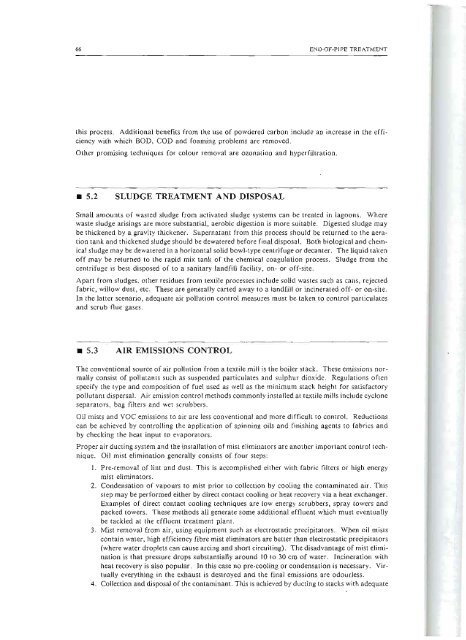Contributor, The Textile Industry and the Environment, UNEP
Contributor, The Textile Industry and the Environment, UNEP
Contributor, The Textile Industry and the Environment, UNEP
Create successful ePaper yourself
Turn your PDF publications into a flip-book with our unique Google optimized e-Paper software.
66 ENO-OF-t,>JPE TREATMENT<br />
this process. Additional benefits from <strong>the</strong> use of powdered carbon include an increase in <strong>the</strong> efficiency<br />
with which BOD, COD <strong>and</strong> foaming problems are removed.<br />
O<strong>the</strong>r promising techniques for colour removal are ozonatioo <strong>and</strong> hyper filtration.<br />
• 5.2 SLUDGE TREATMENT AND DISPOSAL<br />
Small amounts of wasted sludge from activated sludge systems can be treated in lagoons. Where<br />
waste sludge arisings are more substantial, aerobic digestion is more suitable. Digested sludge may<br />
be thickened by a gravity thickener. Supernatant from this process should be returned to <strong>the</strong> aeration<br />
tank <strong>and</strong> thickened sludge should be dewatered before final disposal. Both biological <strong>and</strong> chemical<br />
sludge may be dewatered in a horizontal solid bowl-type centrifuge or decanter. <strong>The</strong> liquid taken<br />
off may be returned to <strong>the</strong> rapid mix tank of <strong>the</strong> chemical coagulation process. Sludge from <strong>the</strong><br />
centrifuge is best disposed of to a sanitary l<strong>and</strong>fill facility, on- or off-site.<br />
Apart from sludges. o<strong>the</strong>r residues from textile processes include solid wastes such as cans, rejected<br />
fabric, willow dust, etc. <strong>The</strong>se are generally carted away to a l<strong>and</strong>fill Or incinerated off- or on-site.<br />
In <strong>the</strong> latter scenario, adequate air pollution control measures must be taken to control particulates<br />
<strong>and</strong> scrub nue gases.<br />
• 5.3 AIR EMISSIONS CONTROL<br />
<strong>The</strong> conventional source of air pollution from a textile mill is <strong>the</strong> boiler stack. <strong>The</strong>se emissions normally<br />
consist of pollutants such as suspended particulates <strong>and</strong> sulphur dioxide. Regulations often<br />
specify <strong>the</strong> type <strong>and</strong> composition of fuel used as well as <strong>the</strong> minimum stack height for satisfactory<br />
pollutant dispersal. Air emission control methods commonly installed at textile mills include cyclone<br />
separators, bag fillers <strong>and</strong> wet scrubbers.<br />
Oil mists <strong>and</strong> VOC emissions to air are less conventional <strong>and</strong> more difficult 10 control. Reductions<br />
can be achieved by controlling <strong>the</strong> application of spinning oils <strong>and</strong> finishing agents to fabrics <strong>and</strong><br />
by checking <strong>the</strong> heat input to evaporators.<br />
Proper air dueling system <strong>and</strong> <strong>the</strong> installation of mist eliminators are ano<strong>the</strong>r important control tech·<br />
nique. Oil mist elimination generally consists of four steps:<br />
I. Pre-removal of lint <strong>and</strong> dust. This is accomplished ei<strong>the</strong>r with fabric filletS or high energy<br />
mist eliminators.<br />
2. Condensation of vapours to mist prior to collection by cooling <strong>the</strong> contaminated air. This<br />
slep may be performed ei<strong>the</strong>r by direct contact cooling Or heat recovery via a heat exchanger.<br />
Examples of direct contact cooling techniques are low energy scrubbers, spray towers <strong>and</strong><br />
packed towers. <strong>The</strong>se methods aU generate some additional efl1uent which must eventually<br />
be tackled at <strong>the</strong> effluent treatment plant.<br />
3. Mist removal from air, using equipment such as electrostatic precipitators. When oil mists<br />
contain water, high efficiency fibre mist eliminators are better than electrostatic precipitators<br />
(where water droplets can cause arcing <strong>and</strong> short circuiting). <strong>The</strong> disadvantage of mist elimination<br />
is that pressure drops substantially around 10 to 30 em of water. Incineration with<br />
heat recovery is also popular. In this case no pre-cooling or condensation is necessary. Virtually<br />
everything in <strong>the</strong> exhaust is destroyed <strong>and</strong> <strong>the</strong> final emissions are odoudess.<br />
4. Collection <strong>and</strong> disposal of <strong>the</strong> contaminant. This is achieved by dueting to stacks with adequate

















